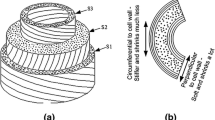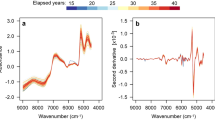Abstract
Wood physical properties and chemical composition are described as self-organizing two-level systems (TLS) and the governing equations are derived. The product of the non-dimensional magnitudes of a physical property and corresponding chemical composition was able to generate power law distributions when the non-dimensional magnitudes were raised to the power of large numbers in the order of 2–26. The TLS analogy was able to reveal the mechanism that creates self-organizing criticality (SOC) from the interactions between two or more high and low dimensional components of wood. As a result of the TLS description, SOC is demonstrated to exist in the couplings of specific gravity and carbohydrates content, specific gravity and extractive substances, shrinkage and carbohydrate content, shrinkage and extractives content. The mechanism is also shown to exist within similar physical and chemical properties if the gross wood has undergone some changes like separation or extraction. Although previous studies failed to find a correlation between some wood properties such as specific gravity and celluloses content, this study revealed the existence of a scale invariant relationship. The scale invariance has an application in dimensional analysis and scaling of inputs to be used in models such as artificial neural networks. It can further have a direct application in developing power law-based models for wood properties. The feasibility of the latter is shown by establishing a scaling relation between shrinkage and dimensionally reduced variables (TLS of alpha-cellulose, lignin, pentosans and specific gravity) as predictors.








Similar content being viewed by others
References
Ahlgren PA, Wood JR, Goring DAI (1972) The fibre saturation point of various morphological subdivisions of Douglas-Fir and Aspen Wood. Wood Sci Technol 6:81–84
Alden AH (1997) Softwoods of North America. General Technical report FPL_GTR-102. USDA, FPL, Madison
Bak P, Tang C, Wiesenfeld K (1988) Self-organized criticality. Phys Rev A 38(1):364–375
Barbero G, Evangelista LR (2004) Two-level system description for the adsorption phenomenon: the meaning of the adsorption energy. Phys Lett A 324:224–226
Brown HJ, West GB (2000) Scaling in biology. Sante Fe Institute, Studies in the Science of Complexity. Oxford University Press, New York
Christenensen GN, Kelsey EK (1958) The sorption of water vapour by the constituents of wood: determination of sorption isotherms. Aust J Appl Sci 9:265–282
Corning AP (2002) The re-emergence of “emergence”: a venerable concept in search of a theory. One solution: the “synergism” hypothesis. Complexity 7(6):18–30
Darveau C, Suarez R, Andrews R, Hochachka P (2002) Allometric cascade as a unifying principle of body mass effects on metabolism. Lett Nat 417(9):166–170
Fan K, Hatzikiriakos SG, Avramidis S (1999) Determination of the surface fractal dimension from sorption isotherms of five softwoods. Wood Sci Technol 33:139–149
Gonzalez SJ (1990) Wood density of Canadian tree species. Northern Region. Information Report NOR-X-315, Forestry Canada, Northwest region, Northern Forestry Center
Hao B, Avramidis S (2001) Wood sorption fractility in the hygroscopic range. Part 1. Evaluation of a modified classic BET model. Wood Fiber Sci 33(1):119–125
Hatzikiriakos GS, Avramidis S (1994) Fractal dimension of wood surfaces from sorption isotherms. Wood Sci Technol 28:275–284
Hellerman S, Swanson I (2007) Charting the landscape of supercritical string theory. Phys Rev Lett 17160:1–1
Kennedy RW, Jaworsky JM (1960) Variation in cellulose content of Douglas-fir. Tappi 43(1):25–27
Kennedy LR, Warren WG (1969) Within-tree variation in physical and chemical properties of Douglas-fir, vol 1. In: Second world consultation on tree breeding FAO/IUFRO, pp 393–417
Pang S, Herritsch A (2005) Physical properties of earlywood and latewood of Pinus radiata D. Don: anisotropic shrinkage, equilibrium moisture content and fiber saturation point. Holzforschung 59:654–661
Pettersen CR (1984) The chemical composition of wood. In: Rowel R (ed) Chemistry of solid wood. US Department of Agriculture
Rawat SPS, Khali PD (1999) Studies on adsorption behaviour of water vapour in lignin using the Brunaur–Emmett–Teller theory. Holz Roh Werkst 57:203–204
Rowell MR, Pettersen R, Han SJ, Rowell SJ, Tshabalala MA (2005) Cell wall chemistry. In: Rowell MR (ed) Handbook of wood chemistry and wood composites. CRC Press, Boca Raton
Saka S (2001) Chemical composition and distribution. In: Hon D, Shiraishi N (eds) Wood and cellulose chemistry, pp 51–80
West GB, Brown JH, Enquist BJ (1999) A general model for the structure and allometry of plant vascular systems. Nature 400:664–667
Zobel B, Buijtenen J (1989) Wood variation—its causes and control. Springer, New York
Acknowledgments
The authors are thankful to Mark Knaebe, David W. Green and James F. Beecher of the USDA Forest Products Laboratory for their resourceful advice. This project was funded by a Discovery Grant from the Natural Sciences and Engineering Research Council of Canada.
Author information
Authors and Affiliations
Corresponding author
Rights and permissions
About this article
Cite this article
Tekleyohannes, A.T., Avramidis, S. Two-level self-organization of wood properties: a new paradigm for dimensional analysis and scaling. Wood Sci Technol 44, 253–268 (2010). https://doi.org/10.1007/s00226-009-0279-9
Received:
Published:
Issue Date:
DOI: https://doi.org/10.1007/s00226-009-0279-9




